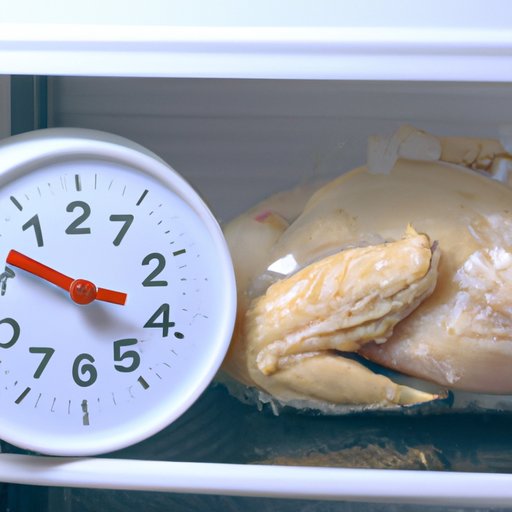Introduction
Thawing chicken is a critical step in food preparation. It is important to thaw chicken properly in order to ensure that it is cooked safely and thoroughly. But how long can you leave chicken out to thaw? This article will explore the recommended timeframes and methods for safely defrosting chicken.
How Long Is Too Long to Thaw Chicken? Tips for Safe Defrosting
Leaving chicken out too long can be dangerous. The optimal temperature range for bacteria to grow on food is 40-140°F (4.4-60°C). If chicken is left at room temperature for more than two hours, bacteria can begin to grow. This can lead to foodborne illness and other health risks, so it is important to know the recommended timeframes for thawing chicken.
The Do’s and Don’ts of Defrosting Chicken: How to Keep Your Food Safe
When it comes to thawing chicken, there are some do’s and don’ts that you should keep in mind. Here are some tips for keeping your food safe when thawing chicken:
Do’s
- Use the refrigerator: The best way to thaw chicken is in the refrigerator. Place the chicken in a sealed container or plastic bag and allow it to defrost slowly over several hours or overnight. This method is the safest and ensures that the chicken stays at a safe temperature throughout the process.
- Place chicken in a sealed container: When thawing chicken in the refrigerator, be sure to place it in a sealed container or plastic bag. This will help keep the chicken from coming into contact with other foods and will also help prevent cross-contamination.
- Use cold water: If you need to defrost chicken quickly, you can use cold water. Place the chicken in a sealed container or plastic bag and submerge it in cold water. Change the water every 30 minutes until the chicken is thawed.
Don’ts
- Leave chicken at room temperature: Never leave chicken at room temperature for more than two hours. Bacteria can begin to grow at this temperature, leading to foodborne illness.
- Use hot water: Hot water can cause the chicken to cook while it is still frozen, resulting in an uneven and potentially unsafe finished product.
- Refreeze chicken: Once chicken has been thawed, it should not be refrozen. Refreezing can reduce the quality of the chicken and can also lead to food safety issues.
Thawing Chicken Safely: What You Need To Know Before Cooking
Before you begin thawing chicken, there are a few things you should keep in mind. First, determine the size of the chicken you are thawing. Smaller pieces of chicken will thaw much faster than larger pieces, so if you are in a hurry, you may want to consider cutting the chicken into smaller pieces before thawing. Second, choose the right thawing method for the size and type of chicken you are thawing. Finally, monitor the temperature of the chicken during the thawing process. Be sure to check the internal temperature of the chicken before cooking to make sure it is at a safe temperature.

The Best Way to Thaw Chicken: Timeframes and Temperature
The best way to thaw chicken is in the refrigerator. This method is the safest and most reliable way to ensure that the chicken stays at a safe temperature during the thawing process. For smaller pieces of chicken, such as boneless skinless chicken breasts, it will take about 12-24 hours to thaw in the refrigerator. For larger pieces of chicken, such as a whole chicken, it will take about 48-72 hours.
If you need to thaw chicken quickly, you can use cold water. Place the chicken in a sealed container or plastic bag and submerge it in cold water. Change the water every 30 minutes until the chicken is thawed. This method will take about 1-2 hours for smaller pieces of chicken, such as boneless skinless chicken breasts, and 2-3 hours for larger pieces of chicken, such as a whole chicken.

Frozen Chicken to Table in No Time: A Guide to Safe Defrosting
Now that you know how long it takes to thaw chicken, here are the steps for safe defrosting:
- Place the chicken in a sealed container or plastic bag.
- If using the refrigerator method, place the chicken in the refrigerator and let it thaw slowly over several hours or overnight.
- If using the cold water method, place the chicken in a sealed container or plastic bag and submerge it in cold water. Change the water every 30 minutes until the chicken is thawed.
- Monitor the temperature of the chicken during the thawing process. Check the internal temperature of the chicken before cooking to make sure it is at a safe temperature.
Once the chicken is thawed, you can tell by feeling if it is ready to cook. If it feels soft and pliable, it is ready to cook. If it is still hard, it needs more time to thaw.
Conclusion
Thawing chicken safely is essential for food safety. It is important to know the recommended timeframes and methods for safely defrosting chicken. The best way to thaw chicken is in the refrigerator, which will take 12-24 hours for smaller pieces and 48-72 hours for larger pieces. You can also use cold water for a quicker thawing process, which will take about 1-2 hours for smaller pieces and 2-3 hours for larger pieces. Monitor the temperature of the chicken during the thawing process and check the internal temperature of the chicken before cooking to make sure it is at a safe temperature. Following these steps for safe thawing will ensure that you can have frozen chicken to table in no time.
(Note: Is this article not meeting your expectations? Do you have knowledge or insights to share? Unlock new opportunities and expand your reach by joining our authors team. Click Registration to join us and share your expertise with our readers.)
